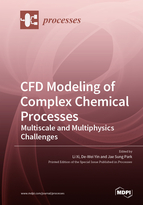CFD Modeling of Complex Chemical Processes: Multiscale and Multiphysics Challenges
A special issue of Processes (ISSN 2227-9717). This special issue belongs to the section "Chemical Processes and Systems".
Deadline for manuscript submissions: closed (31 August 2020) | Viewed by 86874
Special Issue Editors
Interests: chemical engineering computation and modeling; computational fluid dynamics (CFD); molecular simulation; polymer materials and processing; turbulence; transport processes; fluid mixing; polymer dynamics and rheology
Special Issues, Collections and Topics in MDPI journals
Interests: experimental and computational fluid mechanics; modeling of industrial chemical processes; dimensional analysis; molecular simulation
Special Issue Information
Dear Colleagues,
Industrial chemical operations rely on a variety of fluid processes for the handling of materials and energy and the mass production of products. These operations, such as mixing, crystallization, polymerization and other reactive processes, and the complex nature of the fluids (emulsions, suspensions, particulate fluids, etc.) interact via complex coupling relations between momentum, mass, and heat transfer, and reaction kinetics. The prediction of process outcomes from operating parameters is thus a non-trivial challenge in the design, control, and optimization of such processes. Process modeling enabled by computational fluid dynamics (CFD) provides a powerful tool for the understanding and quantifiable description of such processes. CFD modeling of chemical processes is faced with unique challenges. In addition to the coupling between multiple physical processes (transport, rheology, reaction kinetics, etc.), these processes are also often intrinsically multiscale. The wide span of length and time scales of relevance can stem from the complex flow (e.g., turbulence and mixing at different scales), complex fluids (e.g., interplay between fluid microstructure and macroscopic flow), or the coupling between microscopic reaction and diffusion with macroscopic flow and mixing (e.g., emulsion polymerization in a reactor).
We cordially invite your contribution to this Special Issue, which will feature the latest developments in the CFD modeling and simulation of complex industrial processes in chemical and biological engineering, materials processing, advanced manufacturing, petroleum engineering, food and pharmaceutical processing, and other related areas. Contributions describing the application of CFD in chemical processes (either as a standalone tool or in combination with experiments and/or theory), development of new models involving CFD, innovations in numerical methods/algorithms, and the integration of CFD in the process design, control, and optimization are all welcome. Both original research and topical reviews will be considered (authors interested in contributing a review article are asked to discuss its topic scope with the Guest Editors as early as possible). Contributions that feature the methods or application of CFD for addressing the process scale-up challenge are particularly welcome.
We look forward to having the opportunity to showcase your research in the Special Issue!
Dr. Li Xi
Dr. De-Wei Yin
Dr. Jae Sung Park
Guest Editors
Manuscript Submission Information
Manuscripts should be submitted online at www.mdpi.com by registering and logging in to this website. Once you are registered, click here to go to the submission form. Manuscripts can be submitted until the deadline. All submissions that pass pre-check are peer-reviewed. Accepted papers will be published continuously in the journal (as soon as accepted) and will be listed together on the special issue website. Research articles, review articles as well as short communications are invited. For planned papers, a title and short abstract (about 100 words) can be sent to the Editorial Office for announcement on this website.
Submitted manuscripts should not have been published previously, nor be under consideration for publication elsewhere (except conference proceedings papers). All manuscripts are thoroughly refereed through a single-blind peer-review process. A guide for authors and other relevant information for submission of manuscripts is available on the Instructions for Authors page. Processes is an international peer-reviewed open access monthly journal published by MDPI.
Please visit the Instructions for Authors page before submitting a manuscript. The Article Processing Charge (APC) for publication in this open access journal is 2400 CHF (Swiss Francs). Submitted papers should be well formatted and use good English. Authors may use MDPI's English editing service prior to publication or during author revisions.
Keywords
- Computational fluid dynamics (CFD)
- process modeling
- chemical reaction engineering
- mixing
- process scale-up
- multiphase flow
- complex fluids
- multiphysics modeling
- multiscale simulation








